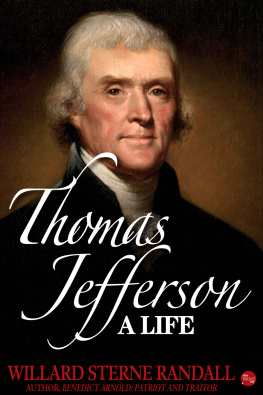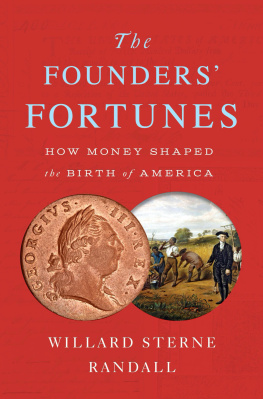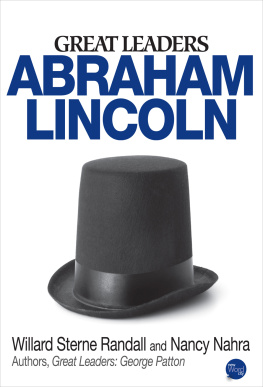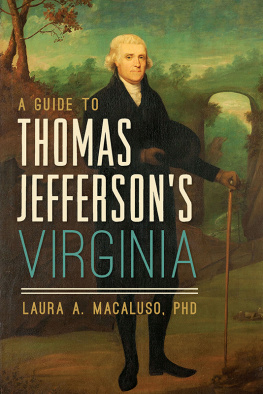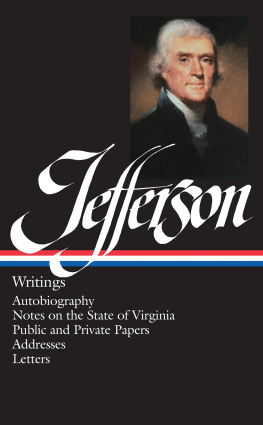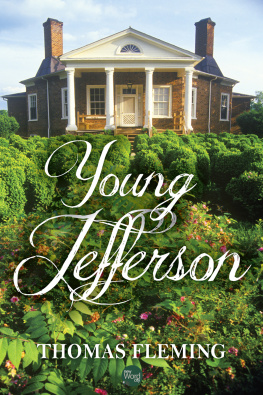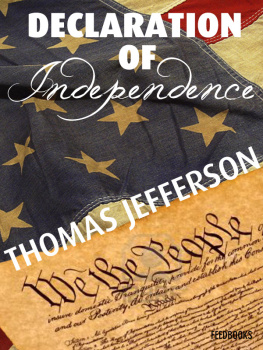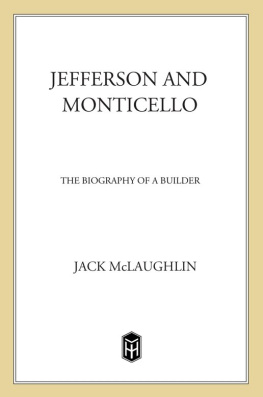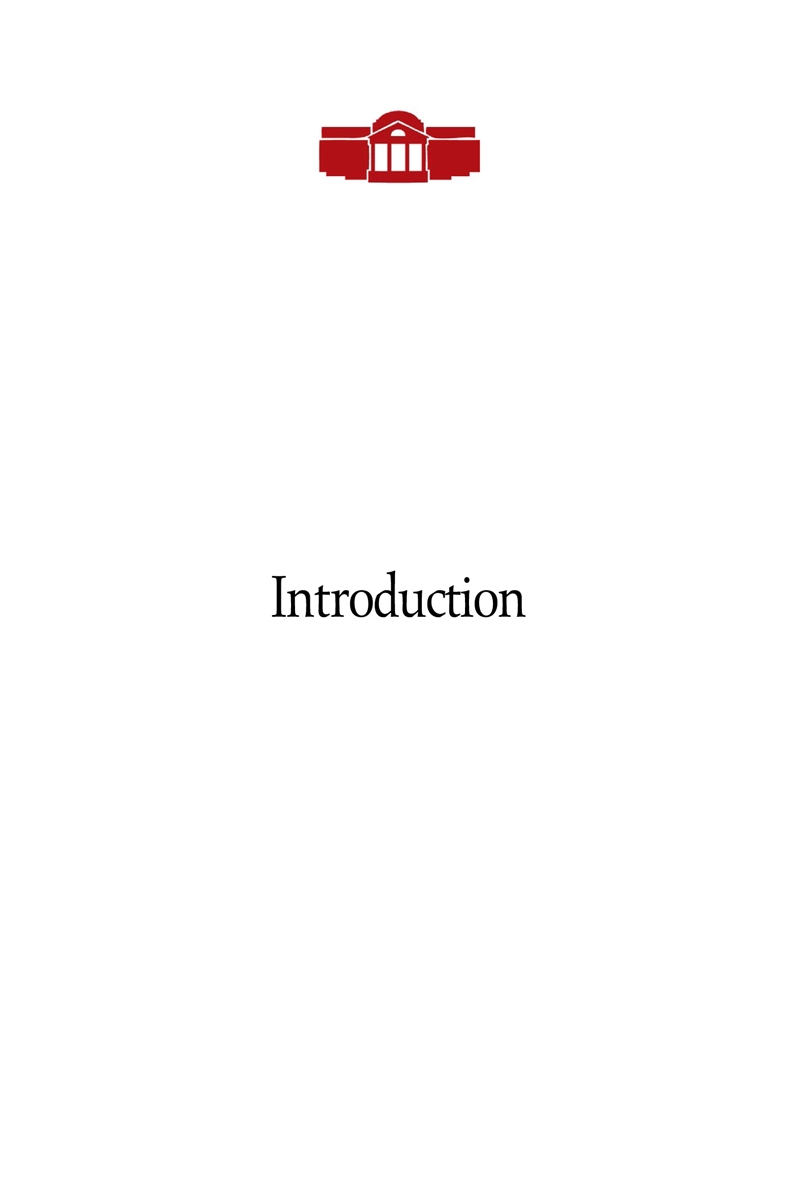
The Genesis of this book came in France when, on breaks from writing an earlier book about Benjamin Franklin and his son, it became clear that Thomas Jefferson was involved when negotiations for the rights of French citizens were under way in the 1780s. Learning about Jefferson from French sources proved disappointing until it was my good fortune to meet Doreen Objois-Peel, for many years a member of the staff of the Benjamin Franklin Documentation Center of the American Embassy in Paris. For twenty-five years, Madame Objois-Peel had hoarded every Jefferson article available while helping to build a first-rate collection on the early American envoys at the embassy. She and her successors, Anne-Marie dAttis and Christianne Laude, allowed me access to the embassys hanging files on all past and present ambassadors. Because of their help I was able to present a paper on Jefferson before the Association France Grande Bretagne at Nice whose president, Professor Pierre Marambaud, a leading authority on colonial America, made his library, along with original and valuable insights, available to me. His daughter, Yvette Salviati, professor of literature at the University of Nice and a Jefferson scholar in her own right, and her husband Grard, introduced me to the private collectionsof the Chevalier de Cessole at the Muse Massena. Paul Malaussena, Olivier Vernier, and Nadine Aimar enhanced my visits to that bibliotheque.
Andr and Florence Pinglier helped me to follow in Jefferson's footsteps through southern France, as did Jean-Pierre and Claudie Thibault, and Adelaide Kane, who drove my wife and me over a route that was no less hair-raising for us in a small car than it must have been for Jefferson on a mule.
At first, I planned to write a book about Jefferson's five years in France, but I was finally and wisely persuaded to expand the work to a full-dress biography by my editor, John Macrae, a man with as keen an eye for biography as anyone I have met. Jack's many helpful suggestions drawn from his apparently inexhaustible knowledge of American history, his generosity with his time, and his gentle yet firm editing more than once helped my flagging courage in taking on the daunting life of Thomas Jefferson.
At every turn, I have received kind assistance from the staffs of archives and libraries that held Jefferson's disparate and voluminous papers, especially at the Henry E. Huntington Library in San Marino, California, at the New York Public Library, at Princeton University Library, at the Thomas Jefferson Memorial Association, and at the Alderman Library of the University of Virginia, which made available microfilm and doctoral dissertations through interlibrary loans. The shared resources of cooperating libraries make works such as this one possible. My deep thanks to Patricia Mardeusz, head of interlibrary loans at the University of Vermont, for tracking down Jefferson materials available on loan from the Universities of Virginia, Minnesota, and Chicago, Mount Holyoke College, the Massachusetts Historical Society, and the New-York Historical Society. Special thanks to Joe Ryan for helping me to search databases to develop several bibliographies, to Nancy Crane and Monica Racine of the Bailey/Howe Library staff, and to Robert Dean, for his sharp-eyed vigilance.
Helpful colleagues at the University of Vermont include Dean Howard Ball of the College of Arts and Sciences, Associate Dean James Lubker, and Professor Patrick Henry Hutton, acting chairman of the History Department. Three research grants from the Dean's Fund and timely funds from the History Department helped to make my archival research and my travels in Jefferson's footsteps easier.
For help at every stage, not only in preparing numerous drafts of the manuscript but in coordinating my efforts to keep the book on schedule while I traveled, I owe great thanks once again to Diann Varricchione. For heroic labors in copyediting, my thanks to Margaret Wolf. Thanks, also, to Nancy Effron, Elizabeth O'Connell, Philip Fitzpatrick, M. Jerome Diamond, Gail Hampton, and Steven Hopkins. To Lawrence Boynton, especial thanks for rounding up hundreds of books. Two people I cannot thank enough: Ray Lincoln, my old friend and longtime literary agent, and my wife, Nancy Nahra, whose numerous suggestions, careful criticisms and extraordinary knowledge of the eighteenth century, its literature, and the classical origins of its thought, have added immeasurably to this effort.
For permission to quote from papers in their collections, I am grateful to the Henry E. Huntington Library; the Bibliothque de Cessole of the Muse Massena, Nice, France; The Bailey/Howe Library of the University of Vermont; the William L. Clements Library of the University of Michigan; the Virginia State Library; the Newberry Library; the Massachusetts Historical Society; the New York Public Library; the New-York Historical Society; Princeton University Library; the Yale University Library for permission to quote from The Papers of Benjamin Franklin, 28 volumes, edited by Leonard W. Larrabee et al.; and from the Papers of Thomas Jefferson, 24 volumes, edited by Julian Boyd, Charles T. Cullen, John Catanzariti et al., published by (or in press from) Princeton University Press. To Professor Boyd and his successors, I and the American people owe an enormous debt.
Jefferson is an old, old subject, noted Merrill Peterson in 1960 in The Jefferson Image in the American Mind, "but the quest for the historical Jefferson, under the formal discipline of scholarly inquiry, is young." Since 1950, when Julian Boyd began to gather some twenty-eight thousand Jefferson letters and documents at Princeton University and, with a small staff, commenced to painstakingly edit and publish them, experts have not only been subjecting each original Jefferson document to critical analysis but have been challenging earlier assumptions about Jefferson's life, thought, motives, and work.
A prime example of this laborious process is their research into Jefferson's Literary Commonplace Book, one of a series of notebooks Jefferson filled with passages that he copied from Greek, Latin, French, and English books throughout his life. They have proven that earlier profiles of Jefferson have been based on flawed translations of classical passages and on misinterpretations and halfhearted biographical analysis written between 1925 and the present day. Many earlier works have sidestepped the problem of dating Jefferson's three commonplace books. Dumas Malone, author of a compendious six-volume study of Jefferson, argued in 1948 that "the dates of the various entries in the notebooks cannot be determined with entire confidence; and, even if they could be, the works that he cited cannot be assumed to have been the source of his ideas.... It is a more important fact that he read widely and stored his mind with riches than that he abstracted particular writings."
Wilson, after patient decades of literary detective work, has discovered that, as an old retired statesman editing his personal papers, Thomas Jefferson cut up, rearranged, and then rebound the literary notebooks he had kept as a young man half a century earlier. Jefferson's edited and rebound version, long accepted by historians such as Chinard, Malone, and Fawn Brodie as being in its original order, created the impression that Jefferson had copied down seemingly misogynistic remarks from Milton, Pope, and from classical Greek and Latin writers after Jefferson flirted timidly and unsuccessfully with Rebecca Burwell when he was twenty-one. Aided by other scholars, historian Wilson has established the dating of watermarks in the paper of the

